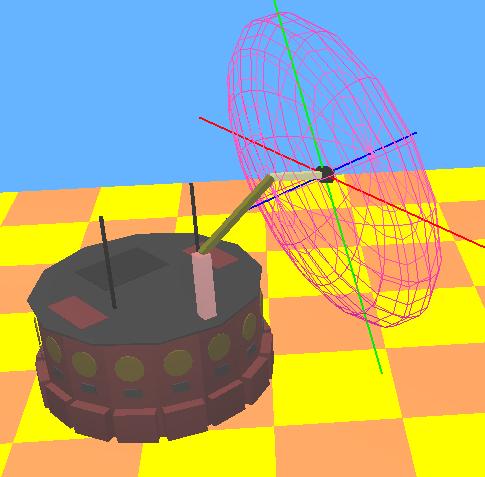

Consider robotic systems made of a nonholonomic mobile base carrying a manipulator (nonholonomic mobile manipulator, NMM). By combining the manipulator differential kinematics with the admissible differential motion of the base, a simple and general kinematic model for NMMs can be derived. If the NMM is kinematically redundant for a given task, one can extend several redundancy resolution schemes originally developed for standard manipulators, in particular the Projected Gradient (PG) and the Reduced Gradient (RG) optimization-based methods [1].
If the mobile base is equipped with steering wheels, the steering velocities do not appear in the first-order time derivative of the task output (for all significant tasks). Simple control by pseudoinversion of the task Jacobian always leads to the impossibility of completing the task. Two kinematic control methods can be designed based on input-output feedback linearization: in a static feedback law, the unspecified steering velocities are defined via an optimization action in the null space of the task Jacobian; in a dynamic feedback law, which builds upon the input-output differential map obtained by considering the task acceleration, the velocity of the steering wheels becomes an active input for task execution, together with the manipulator joint accelerations and the driving accelerations of the platform [2].
For the use of these methods in visual servoing, see also this page.
Documents
The proposed approach has been developed in two papers:
[1] A. De Luca, G. Oriolo, and P. Robuffo Giordano, "Kinematic Modeling and Redundancy Resolution for Nonholonomic Mobile Manipulators," Proc. 2006 IEEE Int. Conf. on Robotics and Automation, Orlando, FL, pp. 1867-1873, 2006.
[2] A. De Luca, G. Oriolo, and P. Robuffo Giordano, "Kinematic Control of Nonholonomic Mobile Manipulators in the Presence of Steering Wheels," Proc. 2010 IEEE Int. Conf. on Robotics and Automation, Anchorage, AK, pp. 1792-1798, 2010.
Videos
1) We present 4 video clips related to the ICRA 2006 paper, showing cases of redundancy resolution with the Reduced Gradient. The tasks are specified for the end-effector of the manipulator.
Unicycle (differential drive) + 2R planar manipulator
Tracking a circular positional task trajectory in the plane with maximization of manipulability (Matlab video)
First link pointing included in the task (Matlab video): T is the pointing target
Second link pointing included in the task (Matlab video): T is the pointing target
Unicycle (differential drive) + 3R spatial manipulator
Tracking a circular positional task trajectory in space with maximization of manipulability (Webots video): the moving green cube is the reference trajectory and the manipulability ellipsoid is also shown
2) We present 8 video clips of kinematic control laws in the presence of steering wheels (ICRA 2010 submission). The tasks are specified for the end-effector of the manipulator.
Car-like + 2R planar manipulator
Tracking a linear positional task trajectory in the plane:
ICRA 2010 video attachment to the submission (mp4)
Set-point Regulation of position and orientation in the plane (not shown in the paper):
Pseudoinverse
of the task Jacobian (Matlab video)
Static feedback with
maximization of manipulability: good stepsize (Matlab video) and too small stepsize (Matlab video)
Dynamic feedback at the task acceleration level (Matlab video)
Car-like + 3R spatial manipulator
Set-Point Regulation of position in space (not shown in the paper; only views from the top):
Pseudoinverse
of the task Jacobian (Matlab video)
Static feedback with
maximization of manipulability (Matlab video)
Dynamic feedback at the task acceleration level (Matlab video)